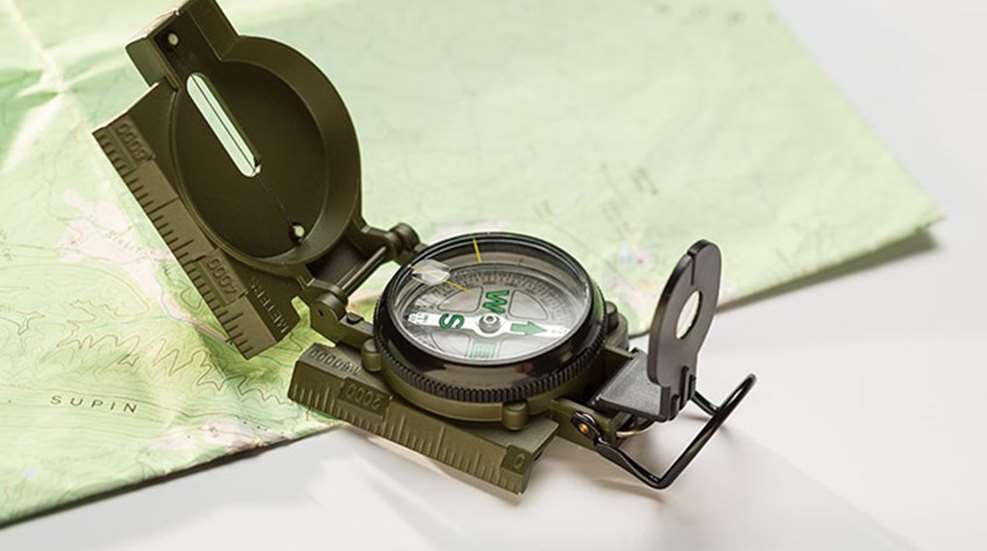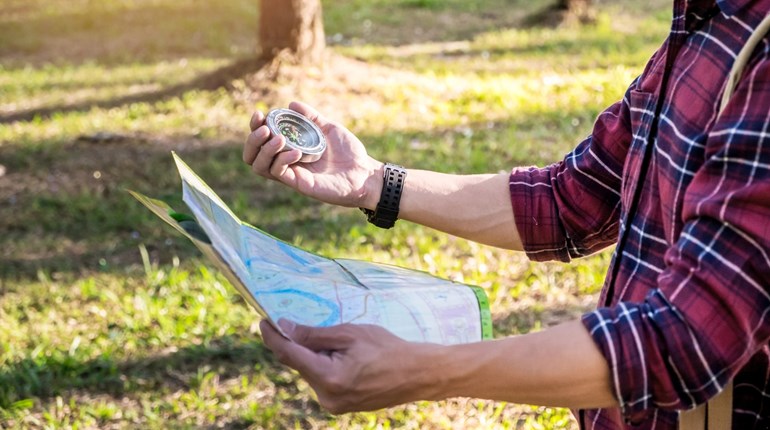** When you buy products through the links on our site, we may earn a commission that supports NRA's mission to protect, preserve and defend the Second Amendment. **

We'll start by confirming that the introduction of affordable Global Positioning Systems (GPS) is a revolution in backwoods survival and orienteering...but as any military commander can tell you, no plan survives first contact with "the enemy." And in this case, "the enemy" is just plain old bad luck. GPS units are relatively complex mechanical devices, and each level of complexity introduces a new point of potential failure. Batteries die, packs get soaked with water, and there's always the more "kinetic" form of damage in which the hiker or hunter falls or drops their GPS. That's why, any time you're heading out into the backwoods, you should carry both an old-school compass and a map of the region. Today, we'll cover some things to know about your compass.
There are many types of compasses available. They range from a simple pocket compass which shows general directions, to complex models with sights and sighting lines, useful for drawing maps or navigating exactly to specific locations. A pocket compass is satisfactory when you just need to know north, south, east and west directions to find your destination. There are two types of pocket compasses: One has a magnetized needle which pivots at its balance point and swings around the dial; the other has a revolving dial instead of a magnetic needle, which turns as the compass is moved.
A compass dial is divided into 360 degrees, numbered clockwise on the dial. The degree numbers shown on the dial are called azimuth directions. The letter N for NORTH is marked at the 0 degree point on the dial. South is at 180 degrees; east at 90 degrees, west at 270 degrees.
Usually one end of the needle is colored, or one end is shaped like an arrowhead so you can tell which end of the needle is pointing to the north. Don't rely on your memory to tell you which end of the needle is the north end. In the confusion that can happen when a person realizes she or he is lost, or if someone is injured, it can become easy to forget which end points north. If there's any chance you will forget which is the north end of the needle, scratch a mark on it. Write on a piece of tape and tape it to the back of the compass, or inside the cover, "north gray," "north red" or "north arrow"...whatever applies to your particular instrument. We also recommend that long before you head out into the wilderness, that you test the compass to see for sure which end of the needle points north. Use it on objects and places where you know for sure which is the true direction.
When you're using your compass, be sure to hold it horizontally and flat. Otherwise, the needle may stick or show an inaccurate reading. The compass must be kept away from metal objects. Stand several feet away from any firearms, axes or knives when taking a compass bearing. (Even a metal belt buckle might be enough to distort the needle's action, believe it or not.) If you are near bridge girders or railroad tracks, move to a different position that is distant from the metal structure.
Here's an example; we'll use a hunter in this scenario, but of course this would apply to a hiker or camper just as easily. Let's say, if a hunter decides to stalk deer in a range of hills about two miles distant from camp, he would take a compass reading before leaving camp. If the compass showed the direction of the hills as southwest of camp, he would know that after hunting in the hills he must walk northeast from the hills to get back to camp. He should be double-checking his direction at intervals along the way.
Should our hypothetical hunter, on reaching the hills, then walk several more miles, he must take this into account when reading the compass for directions back to camp. If he had turned to the right when he reached the hills and walked in that direction f r several miles, he would then be almost directly west of camp, not southwest as he was upon leaving camp. To get back to camp, he must now travel east.
General compass directions such as these, although not exact, are accurate enough to direct a hunter who has traveled only a few miles' distance back to camp. Following the compass directions will bring him back to the general area where he began his trek, and he will then be able to recognize landmarks which tell him exactly where the camp is.
When camp has been set up beside a "baseline" such as a river, road or railway, the hunter can easily find his way back to camp with a compass. If he is hunting north of the baseline, he knows that as long as he doesn't cross that baseline all he needs to do to find camp is walk south from where he is and he'll be in line with the site.
There are many types of compasses available. They range from a simple pocket compass which shows general directions, to complex models with sights and sighting lines, useful for drawing maps or navigating exactly to specific locations. A pocket compass is satisfactory when you just need to know north, south, east and west directions to find your destination. There are two types of pocket compasses: One has a magnetized needle which pivots at its balance point and swings around the dial; the other has a revolving dial instead of a magnetic needle, which turns as the compass is moved.
A compass dial is divided into 360 degrees, numbered clockwise on the dial. The degree numbers shown on the dial are called azimuth directions. The letter N for NORTH is marked at the 0 degree point on the dial. South is at 180 degrees; east at 90 degrees, west at 270 degrees.
Usually one end of the needle is colored, or one end is shaped like an arrowhead so you can tell which end of the needle is pointing to the north. Don't rely on your memory to tell you which end of the needle is the north end. In the confusion that can happen when a person realizes she or he is lost, or if someone is injured, it can become easy to forget which end points north. If there's any chance you will forget which is the north end of the needle, scratch a mark on it. Write on a piece of tape and tape it to the back of the compass, or inside the cover, "north gray," "north red" or "north arrow"...whatever applies to your particular instrument. We also recommend that long before you head out into the wilderness, that you test the compass to see for sure which end of the needle points north. Use it on objects and places where you know for sure which is the true direction.
When you're using your compass, be sure to hold it horizontally and flat. Otherwise, the needle may stick or show an inaccurate reading. The compass must be kept away from metal objects. Stand several feet away from any firearms, axes or knives when taking a compass bearing. (Even a metal belt buckle might be enough to distort the needle's action, believe it or not.) If you are near bridge girders or railroad tracks, move to a different position that is distant from the metal structure.
Here's an example; we'll use a hunter in this scenario, but of course this would apply to a hiker or camper just as easily. Let's say, if a hunter decides to stalk deer in a range of hills about two miles distant from camp, he would take a compass reading before leaving camp. If the compass showed the direction of the hills as southwest of camp, he would know that after hunting in the hills he must walk northeast from the hills to get back to camp. He should be double-checking his direction at intervals along the way.
Should our hypothetical hunter, on reaching the hills, then walk several more miles, he must take this into account when reading the compass for directions back to camp. If he had turned to the right when he reached the hills and walked in that direction f r several miles, he would then be almost directly west of camp, not southwest as he was upon leaving camp. To get back to camp, he must now travel east.
General compass directions such as these, although not exact, are accurate enough to direct a hunter who has traveled only a few miles' distance back to camp. Following the compass directions will bring him back to the general area where he began his trek, and he will then be able to recognize landmarks which tell him exactly where the camp is.
When camp has been set up beside a "baseline" such as a river, road or railway, the hunter can easily find his way back to camp with a compass. If he is hunting north of the baseline, he knows that as long as he doesn't cross that baseline all he needs to do to find camp is walk south from where he is and he'll be in line with the site.







































